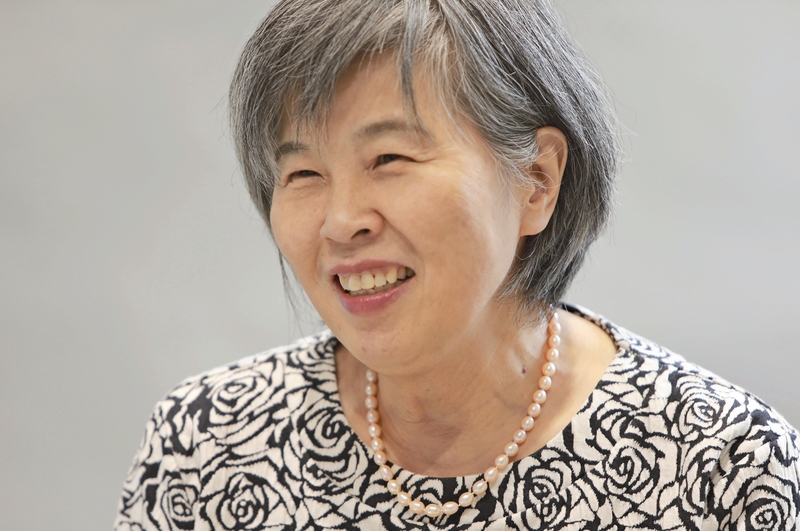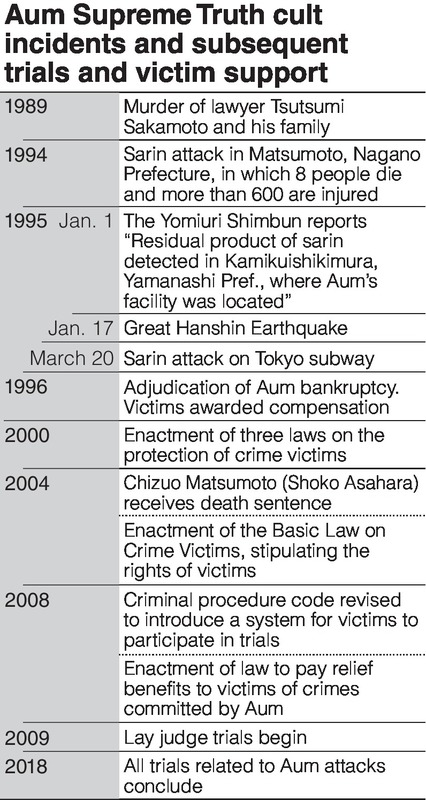
On the morning of March 20, 1995, the Aum Supreme Truth doomsday cult released the highly toxic nerve gas sarin in five train cars on three lines of Tokyo's Eidan subway (now Tokyo Metro) passing through Kasumigaseki Station. Thirteen people were killed and more than 6,000 sickened.
This indiscriminate act of terror targeting the government district during the weekday rush hour would cause Shizue Takahashi, a woman who had enjoyed a happy life, to become embroiled in a lengthy battle with Aum. We asked Takahashi, who lost her husband in the attack, to look back on the past 23 years.

I called Kasumigaseki Station, where my husband was finishing his night shift, several times that morning to talk about the trip to Hokkaido we were going to take for our wedding anniversary. But I couldn't get through.
[Then 50-year-old Kazumasa Takahashi, an assistant stationmaster at Kasumigaseki Station on the Chiyoda Line, died when he was exposed to sarin gas while removing a bag containing the nerve agent from a train car. Takahashi's wife Shizue was 48 years old at the time. In addition to being a homemaker, she also worked part-time at a bank.]
Initially, there were reports of an explosion on the Hibiya Line, so I was worried about my eldest son, who was working at Eidan's Roppongi Station. My younger sister was watching the television, and she told me that one of the staff taken to the hospital looked like my husband. I thought, "What should I do?" The electronic news ticker in the bank lobby was giving disturbing reports.
I went to Eidan's head office in a car the bank provided for me. The television there showed my husband on a stretcher. Wondering why such a thing would happen, I headed to the hospital in tears. I remember the scene in the hospital room vividly. My husband was lying there and his face was so pale. They had removed his jacket, and his dress shirt was unbuttoned, maybe to give him a cardiac massage.
They did the autopsy the following day, and I remember the long wait for them to return my husband to me, as well as going to pick up his personal effects and other things from Kasumigaseki Station on March 25. His uniform and toiletries ... The sight when I opened my husband's locker is as clear in my mind as a photograph. They said they would send his things, but the four of us in my family carried them ourselves. It was raining, so we used umbrellas like shields and headed home.
[Even as the investigation into the incident progressed and the cult members were indicted, the victims never received a proper explanation. During the criminal case at the time, the victims and surviving families were treated as "evidence." They did not know the day of the trial, and there were no seats set aside for them in the courtroom. Assistance for the victims of the indiscriminate terror attack was insufficient. Shizue spoke up against each injustice, and worked tirelessly to see that the victims' rights were protected in the Aum trials and negotiations with the government.]
I didn't throw myself into becoming a representative manager for victims groups. I had never imagined that my life would be transformed this way, negotiating with the government, testifying in court and surrounded by the media.
Then and now, the victims have dealt with hardship, and many are troubled by the aftereffects. About three years after the incident, I was diagnosed with PTSD myself. However, there were a lot of things I was working toward, like the realization of a benefits law that would enable the victims of the Aum incidents and surviving families to receive relief payments. Maybe because every day was so hectic, I didn't grasp my own condition at first.
[Due to the outcry from many victims, the Basic Law on Crime Victims was enacted in 2004, followed by a 2008 law to provide state benefits to victims of crimes committed by the Aum Supreme Truth cult. A system for victims to participate in criminal trials was also implemented, enabling victims to question the accused.]
I think significant progress has been made during the Heisei era in supporting victims of crime. What was my motivation to continue speaking up? This might seem dramatic, but it was a feeling that I didn't want to be killed by Aum, and I didn't want Aum to cripple my soul. The successor groups to Aum are still dangerous. They have no common sense and cannot understand the human soul.
[All the trials related to the Aum attacks were concluded in January, with death sentences handed down for 13 perpetrators, including Shoko Asahara (real name: Chizuo Matsumoto, 63), who ordered the murder of lawyer Tsutsumi Sakamoto and his family and the sarin attacks in Matsumoto, Nagano Prefecture, and on the Tokyo subway. The future executions will be a focus of attention.]
I have attended 459 sessions of the Aum trials. Through the trials, I think I learned the whole picture of the incidents. Asahara aside, the condemned prisoners must all know that they did hideous things. Even his disciples who have not apologized maintain an unrepentant attitude, because they would otherwise break down.
There are some prisoners on death row I want to meet. There are some who have come to accept their part in the incidents, and had a change of heart after hearing the surviving families speak. While it is not an "exchange" by any means, I have interacted with some people by receiving letters, etc. I think about those people differently than I do about Asahara. I have nothing at all to say to Asahara.
The judges decided on the death penalty after agonizing over the matter for many years, and the sentence was finalized after going through the appeals process and the Supreme Court. Since the death penalty is currently permitted, I expect that it will be carried out.
[Lately, when she attends lectures on victim support and other matters, people tell her, "I'm glad to see you smiling."]
Maybe I've become a little stronger, I'm no longer a person who only grieves all of the time. I think the image of victims as always crying, angry and needing to be gloomy is fabricated to begin with.
After the incident, a series of problems that I needed to confront arose, and I became a different person after addressing each of them. In the United States, I learned of the generous support offered to victims of crime and interacted with families of those who died in the September 11 terror attack, which also played a big part. In a way, I've been supported by my lateral connections with victims of crime both here and abroad.
[At the start of this year, Takahashi released Kazumasa's death certificate through the Public Security Intelligence Agency's website. The cause of death is listed as poisoning by an organic phosphorous compound, with a mark checked next to "murder."]
I couldn't face it before, but there are many younger people now who don't know about the incident, 23 years later. I was hoping people would see and realize that this was something that happened in real life. There is no comprehensive report on the Aum terror attack by the government or other entities. Even the number of victims in the subway sarin attack differs depending on the investigative agency, government office or media outlet. Is that acceptable for a major incident that rocked the nation?
March 20 was the worst moment in my life, but there is another moment that stands out for me. Before the incident, without a doubt ... without a doubt, I had a happy life with my husband. So much so that I had decided that I would say "Thank you" when the end came, even if the incident had not happened.
I used to talk about the future with my husband often, about traveling somewhere else or what to do after his retirement. That's the time that I lost. Even now, when I'm at a loss about victim support or handling the media, I think, "I wish my husband were here at times like this." It's funny, isn't it?
--This interview was conducted by Yomiuri Shimbun Senior Writer Natsuki Komatsu.
(From The Yomiuri Shimbun, April 11, 2018)
Read more from The Japan News at https://japannews.yomiuri.co.jp/







